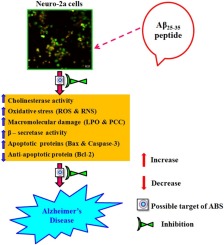当前位置:
X-MOL 学术
›
Colloids Surf. B Biointerfaces
›
论文详情
Our official English website, www.x-mol.net, welcomes your feedback! (Note: you will need to create a separate account there.)
Deciphering the anti-apoptotic potential of α-bisabolol loaded solid lipid nanoparticles against Aβ induced neurotoxicity in Neuro-2a cells.
Colloids and Surfaces B: Biointerfaces ( IF 5.8 ) Pub Date : 2020-03-05 , DOI: 10.1016/j.colsurfb.2020.110948 Sethuraman Sathya 1 , Balakrishnan Shanmuganathan 1 , Kasi Pandima Devi 1
Colloids and Surfaces B: Biointerfaces ( IF 5.8 ) Pub Date : 2020-03-05 , DOI: 10.1016/j.colsurfb.2020.110948 Sethuraman Sathya 1 , Balakrishnan Shanmuganathan 1 , Kasi Pandima Devi 1
Affiliation

|
Nanoparticles based drug delivery system offers an alternative strategy to overcome several therapeutic limitations of various human ailments, particularly in age-linked Alzheimer's disease. Results of our previous cell-free studies indicated that α-bisabolol loaded solid lipid nanoparticles (ABS) significantly inhibited the aggregation of Aβ25-35. The present study intended to evaluate the neuroprotective effect of ABS against Aβ25-35 induced toxicity in Neuro-2a cell lines. The results of in vitro cell line study revealed that pretreatment of Neuro-2a cell lines with ABS (5 & 10 μg/ml) significantly suppressed the production of free radicals such as reactive oxygen species (ROS)/reactive nitrogen species (RNS), and also augmented the ROS mediated macromolecular damages and loss of mitochondrial membrane potential induced by toxic Aβ peptide when compared to the standard drug donepezil (50 μg/ml). Moreover, reduced β-secretase, caspase-3, and cholinesterase activities were observed in the cells pretreated with ABS, which clearly evidenced the neuroprotective effect of ABS. Reduced expression of Bax and induced expression of Bcl-2 proteins observed through western blot analysis and live/dead cell viability analysis of Neuro-2a cells through confocal microscope further validated that ABS protects the cells from Aβ induced apoptosis. Taken together, the outcome of the present study signifies the neuroprotective effect of ABS against the Aβ induced toxicity in in vitro model of Neuro-2a cells.
中文翻译:

破译载有α-bisabolol的固体脂质纳米颗粒对Aβ诱导的Neuro-2a细胞神经毒性的抗凋亡潜力。
基于纳米颗粒的药物递送系统提供了一种替代策略,可以克服各种人类疾病的多种治疗局限性,尤其是在与年龄相关的阿尔茨海默氏病中。我们先前的无细胞研究结果表明,装载α-双糖醇的固体脂质纳米颗粒(ABS)显着抑制了Aβ25-35的聚集。本研究旨在评估ABS对Neuro-2a细胞系中Aβ25-35诱导的毒性的神经保护作用。体外细胞系研究结果表明,用ABS(5&10μg/ ml)预处理Neuro-2a细胞系可显着抑制自由基的产生,例如活性氧(ROS)/活性氮(RNS),与标准药物多奈哌齐(50μg/ ml)相比,由毒性Aβ肽诱导的ROS介导的大分子损伤和线粒体膜电位损失也增加了。而且,在用ABS预处理的细胞中观察到β-分泌酶,caspase-3和胆碱酯酶活性降低,这清楚地证明了ABS的神经保护作用。通过共聚焦显微镜通过Western印迹分析和Neuro-2a细胞的活/死细胞生存力分析观察到Bax的表达减少和Bcl-2蛋白的诱导表达进一步证实了ABS保护细胞免受Aβ诱导的细胞凋亡。综上所述,本研究的结果表明,在Neuro-2a细胞体外模型中,ABS对Aβ诱导的毒性具有神经保护作用。而且,在用ABS预处理的细胞中观察到β-分泌酶,caspase-3和胆碱酯酶活性降低,这清楚地证明了ABS的神经保护作用。通过共聚焦显微镜通过Western印迹分析和Neuro-2a细胞的活/死细胞生存力分析观察到Bax的表达减少和Bcl-2蛋白的诱导表达进一步证实了ABS保护细胞免受Aβ诱导的细胞凋亡。综上所述,本研究的结果表明,在Neuro-2a细胞体外模型中,ABS对Aβ诱导的毒性具有神经保护作用。而且,在用ABS预处理的细胞中观察到β-分泌酶,caspase-3和胆碱酯酶活性降低,这清楚地证明了ABS的神经保护作用。通过共聚焦显微镜通过Western印迹分析和Neuro-2a细胞的活/死细胞生存力分析观察到Bax的表达减少和Bcl-2蛋白的诱导表达进一步证实了ABS保护细胞免受Aβ诱导的细胞凋亡。综上所述,本研究的结果表明,在Neuro-2a细胞体外模型中,ABS对Aβ诱导的毒性具有神经保护作用。通过共聚焦显微镜通过Western印迹分析和Neuro-2a细胞的活/死细胞生存力分析观察到Bax的表达减少和Bcl-2蛋白的诱导表达进一步证实了ABS保护细胞免受Aβ诱导的细胞凋亡。综上所述,本研究的结果表明,在Neuro-2a细胞体外模型中,ABS对Aβ诱导的毒性具有神经保护作用。通过共聚焦显微镜通过Western印迹分析和Neuro-2a细胞的活/死细胞生存力分析观察到Bax的表达减少和Bcl-2蛋白的诱导表达进一步证实了ABS保护细胞免受Aβ诱导的细胞凋亡。综上所述,本研究的结果表明,在Neuro-2a细胞体外模型中,ABS对Aβ诱导的毒性具有神经保护作用。
更新日期:2020-03-05
中文翻译:

破译载有α-bisabolol的固体脂质纳米颗粒对Aβ诱导的Neuro-2a细胞神经毒性的抗凋亡潜力。
基于纳米颗粒的药物递送系统提供了一种替代策略,可以克服各种人类疾病的多种治疗局限性,尤其是在与年龄相关的阿尔茨海默氏病中。我们先前的无细胞研究结果表明,装载α-双糖醇的固体脂质纳米颗粒(ABS)显着抑制了Aβ25-35的聚集。本研究旨在评估ABS对Neuro-2a细胞系中Aβ25-35诱导的毒性的神经保护作用。体外细胞系研究结果表明,用ABS(5&10μg/ ml)预处理Neuro-2a细胞系可显着抑制自由基的产生,例如活性氧(ROS)/活性氮(RNS),与标准药物多奈哌齐(50μg/ ml)相比,由毒性Aβ肽诱导的ROS介导的大分子损伤和线粒体膜电位损失也增加了。而且,在用ABS预处理的细胞中观察到β-分泌酶,caspase-3和胆碱酯酶活性降低,这清楚地证明了ABS的神经保护作用。通过共聚焦显微镜通过Western印迹分析和Neuro-2a细胞的活/死细胞生存力分析观察到Bax的表达减少和Bcl-2蛋白的诱导表达进一步证实了ABS保护细胞免受Aβ诱导的细胞凋亡。综上所述,本研究的结果表明,在Neuro-2a细胞体外模型中,ABS对Aβ诱导的毒性具有神经保护作用。而且,在用ABS预处理的细胞中观察到β-分泌酶,caspase-3和胆碱酯酶活性降低,这清楚地证明了ABS的神经保护作用。通过共聚焦显微镜通过Western印迹分析和Neuro-2a细胞的活/死细胞生存力分析观察到Bax的表达减少和Bcl-2蛋白的诱导表达进一步证实了ABS保护细胞免受Aβ诱导的细胞凋亡。综上所述,本研究的结果表明,在Neuro-2a细胞体外模型中,ABS对Aβ诱导的毒性具有神经保护作用。而且,在用ABS预处理的细胞中观察到β-分泌酶,caspase-3和胆碱酯酶活性降低,这清楚地证明了ABS的神经保护作用。通过共聚焦显微镜通过Western印迹分析和Neuro-2a细胞的活/死细胞生存力分析观察到Bax的表达减少和Bcl-2蛋白的诱导表达进一步证实了ABS保护细胞免受Aβ诱导的细胞凋亡。综上所述,本研究的结果表明,在Neuro-2a细胞体外模型中,ABS对Aβ诱导的毒性具有神经保护作用。通过共聚焦显微镜通过Western印迹分析和Neuro-2a细胞的活/死细胞生存力分析观察到Bax的表达减少和Bcl-2蛋白的诱导表达进一步证实了ABS保护细胞免受Aβ诱导的细胞凋亡。综上所述,本研究的结果表明,在Neuro-2a细胞体外模型中,ABS对Aβ诱导的毒性具有神经保护作用。通过共聚焦显微镜通过Western印迹分析和Neuro-2a细胞的活/死细胞生存力分析观察到Bax的表达减少和Bcl-2蛋白的诱导表达进一步证实了ABS保护细胞免受Aβ诱导的细胞凋亡。综上所述,本研究的结果表明,在Neuro-2a细胞体外模型中,ABS对Aβ诱导的毒性具有神经保护作用。



























 京公网安备 11010802027423号
京公网安备 11010802027423号